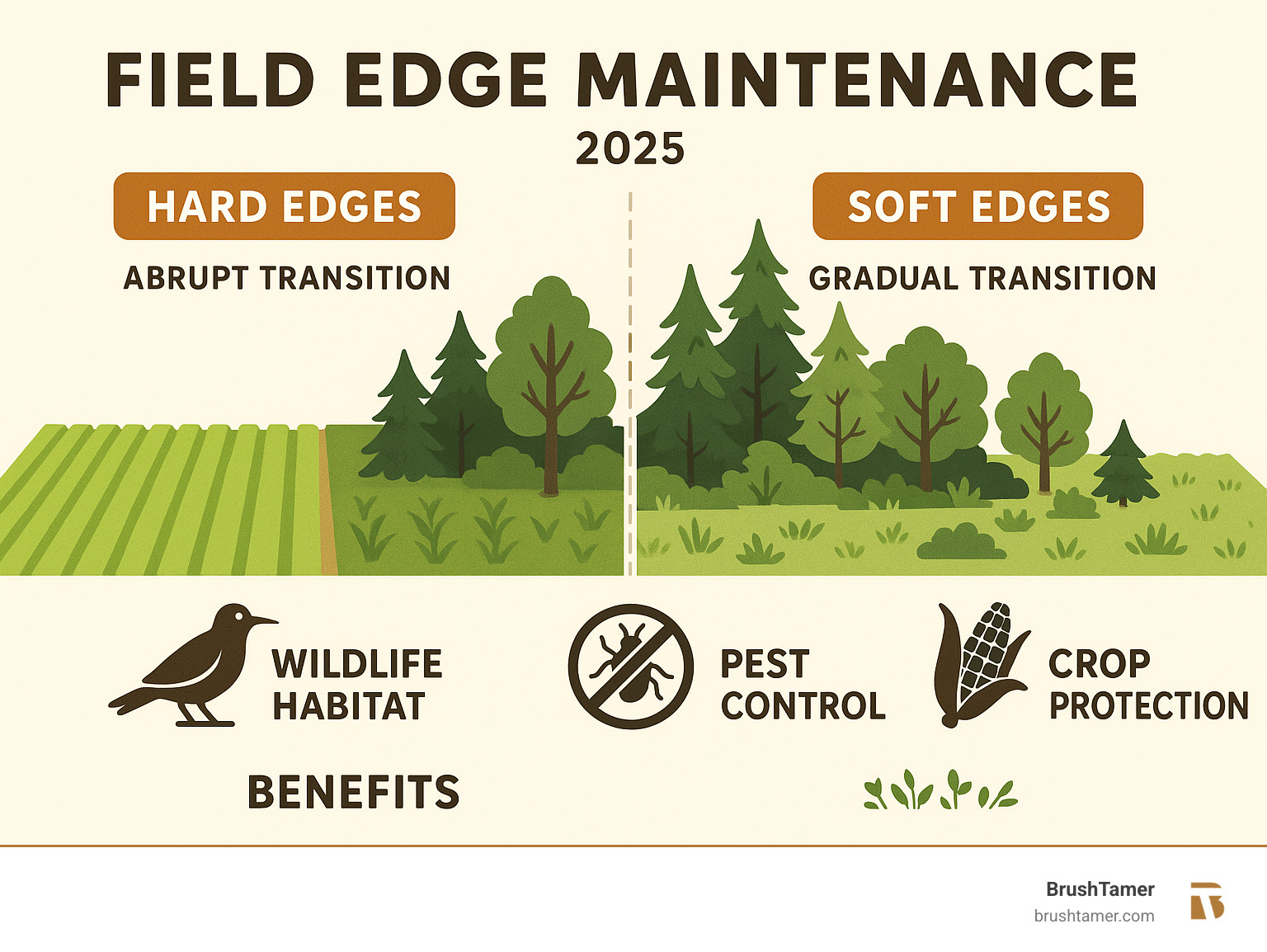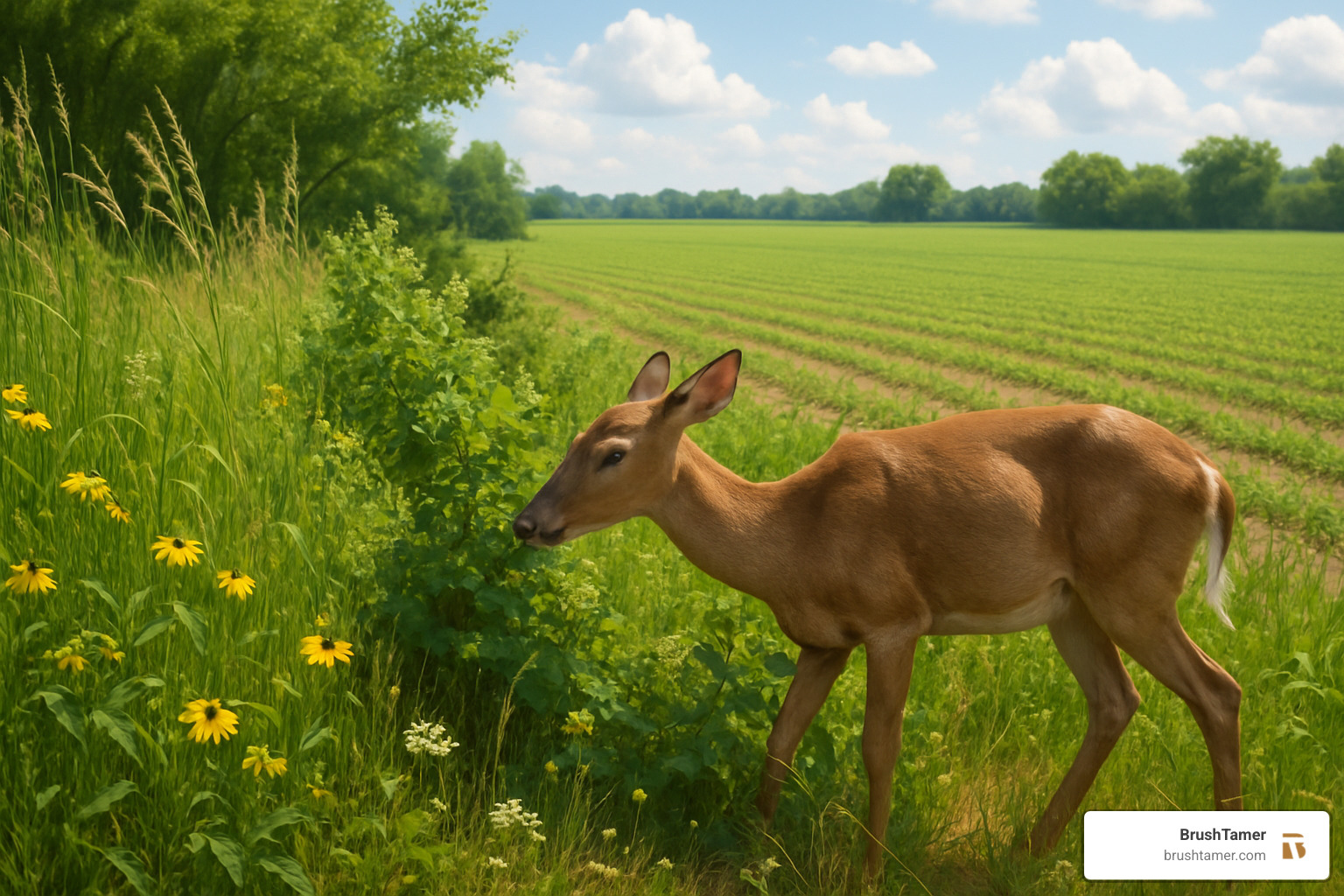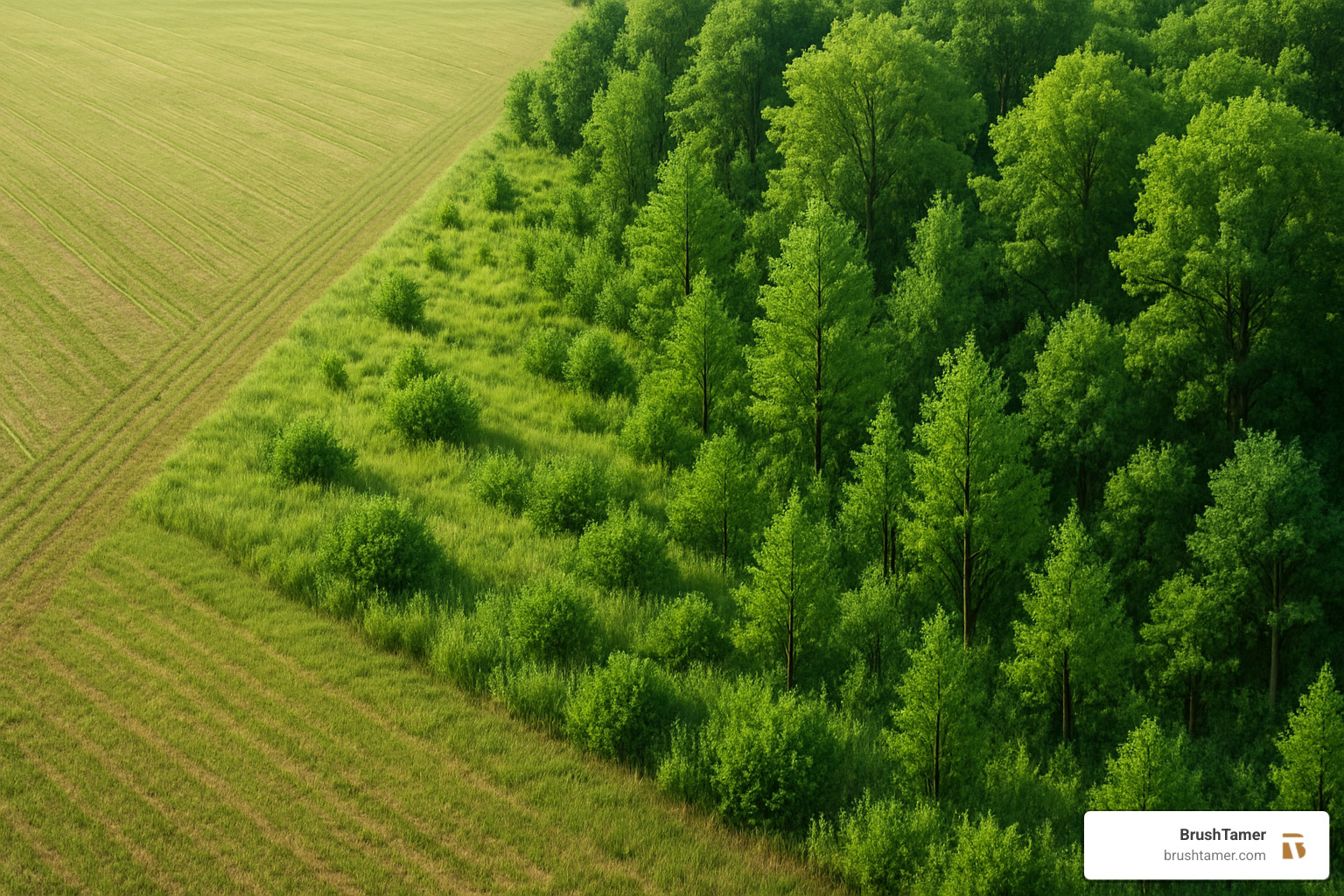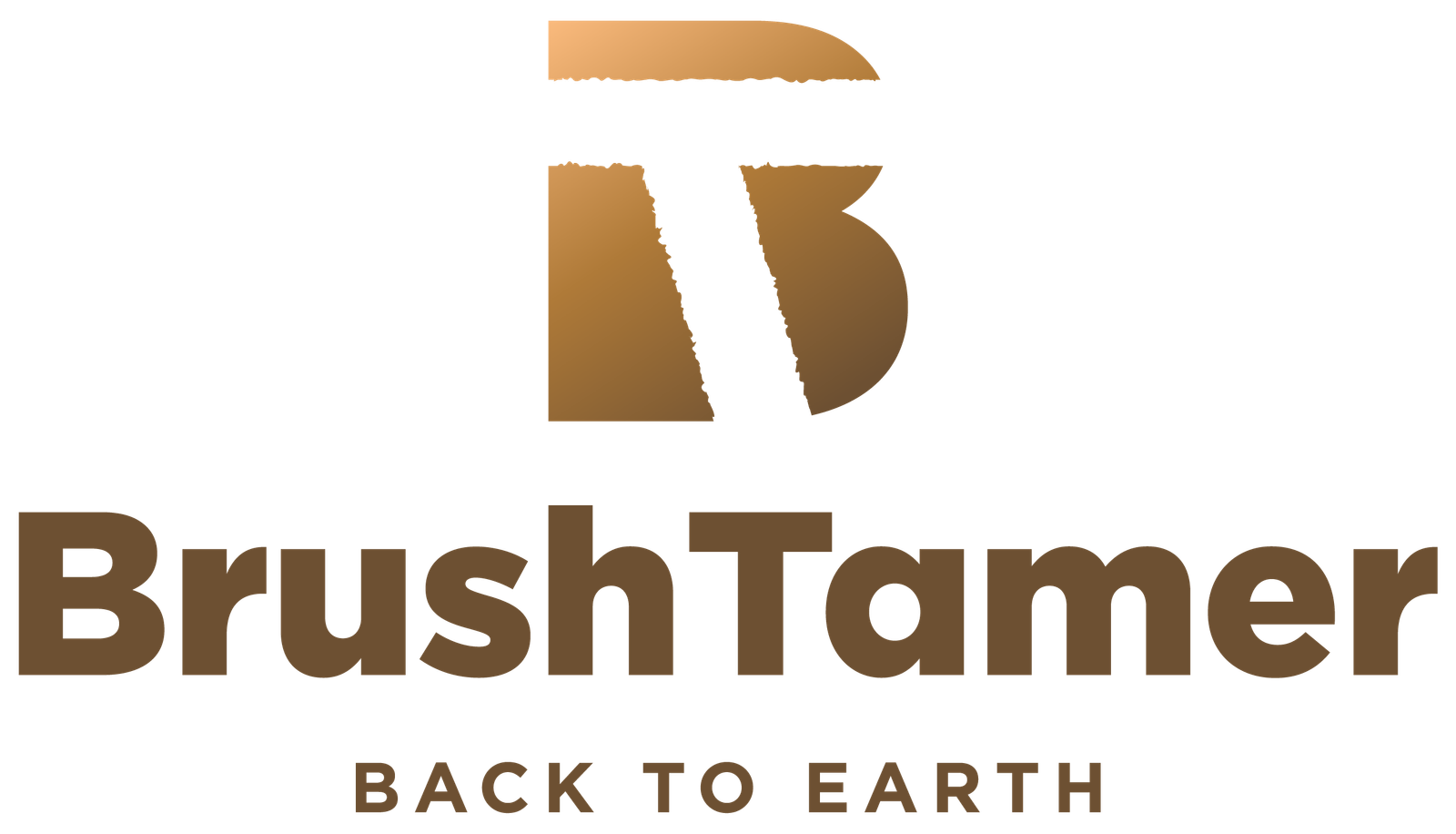Why Field Edge Maintenance Matters for Your Property
Field edge maintenance is simply the care you give to the strip where cropland, pasture, and natural habitat meet. Done well, it protects yields, boosts wildlife, and keeps soil and water where they belong.
Quick Overview: Field Edge Maintenance Essentials
- Assess goals – wildlife, crop protection, or both
- Choose techniques – feathering, rotational mowing, selective cutting
- Gather tools – saws, mowers, herbicide sprayer, safety gear
- Work safely – observe nesting seasons, use PPE
- Monitor regularly – revisit every 3-5 years
Research shows soft, well-managed edges don’t reduce overall yields. In many cases they help—beneficial insects thrive, unprofitable border acres are retired, and pest pressure drops. Warm-season grass borders, for example, have cut European corn borer damage by up to three-fold.
Transitional zones also serve as wildlife corridors for pollinators, birds, deer, and more. After years of forestry-mulching projects across Indiana, I’ve seen first-hand how thoughtful edge work raises both property value and ecological health.

The Dual Benefits of Field Edge Maintenance
Agronomic and Economic Advantages
Edge rows beside mature timber can suffer 30 % yield loss from shade and root competition. Turning those marginal acres into habitat saves seed, fertilizer, and fuel while qualifying for conservation payments. One 500-acre study farm netted $25 per enrolled acre and avoided another $164 per acre in input costs.
Pest control improves too. Warm-season grass borders reduced European corn borer infestations by up to three times, and fields next to pollinator plantings saw 10–30 % higher soybean yields thanks to better pollination and fewer pests. Add in less erosion and cleaner runoff, and the economics are hard to ignore.
Ecological and Wildlife Advantages
A single hedgerow can host hundreds of plant species and over a thousand insects. Properly feathered woodland edges and grass margins increase local bird numbers by 50–100 %, give deer secure browse, and keep pollinators fed from early spring through fall. Even small corners or 30-foot strips link habitats across today’s large field blocks, acting like wildlife highways.

Bottom line: invest a little time at the edges and you’ll see compounding returns in both profit and biodiversity.
Step 1: Assess Your Goals and Plan Your Approach
Every property is different, so start by walking your boundaries and deciding what you want most: higher yields, better habitat, or a balance of both.
Know Your Edge Types
- Hedgerows – linear thickets that connect habitats and shelter over 65 bird species.
- Woodland edges – where shade and roots rob crops; prime spots for edge feathering.
- Grass margins & ditches – great for pollinators and filtering runoff.
Timing & Width
- Avoid major cutting March 31–August (peak nesting).
- For nesting habitat, aim for 30 ft+ borders; even 15 ft helps if space is tight.
- Respect tree roots: stay outside a zone equal to 15× trunk diameter or 5 m beyond the canopy, whichever is greater.
Rotating management—treating a different section each year—keeps some cover intact while you work toward your goals.
Step 2: Choose the Right Maintenance Techniques
Edge Feathering & Hinge Cutting
Feathering removes selected trees 15–20 yd inside the timber to create a stair-step of grasses, shrubs, and scattered trees. Leave mast and fruit producers; drop quick-sprouting species like elm or dogwood to provide future browse. A well-executed hinge cut keeps part of the cambium intact so the tree stays alive, bends for cover, and sprouts fresh growth.
Place felled trees perpendicular to the field for free movement (open feathering) or parallel to funnel wildlife (closed feathering).

Rotational Mowing & Disking
Grass strips and field corners stay healthiest with disturbance every 3–5 years. Mow or disk in late fall or winter after flowers have set seed, never during peak nesting or bloom. Stagger work so only a fraction of the edge is disturbed each season, maintaining a mosaic of heights and plant ages.
Step 3: Gather the Correct Tools and Equipment
Having the right gear makes the job safer and more efficient. Over the years, we’ve learned that proper equipment selection can make the difference between a successful project and a frustrating, potentially dangerous experience.
The tools you’ll need depend on the scope of your field edge maintenance project. For smaller jobs involving light brush and individual trees, hand tools like a properly maintained chainsaw with a sharp chain will handle most cutting tasks. You’ll also want loppers for smaller branches, a handsaw for precision work, and a herbicide sprayer for treating stumps to prevent regrowth.
Safety should never be an afterthought. Essential safety gear includes personal protective equipment (PPE), chainsaw chaps, a hard hat or helmet, cut-resistant gloves, and eye and hearing protection. I always recommend keeping a first aid kit nearby when working with cutting tools. These items aren’t optional – they’re what keep you safe when things go wrong.
For larger projects or open areas, heavy equipment becomes necessary. A tractor with mower attachment works well for maintaining grass margins and field corners. Disk harrows help create the soil disturbance needed for encouraging beneficial plants. Skid steers with brush cutter attachments can handle medium-sized clearing projects efficiently.
Property owners who prefer tackling smaller projects themselves can accomplish quite a bit with hand tools and basic safety equipment. Edge feathering projects up to a few acres are definitely manageable for motivated landowners with the right approach and proper safety precautions.
Essential Tools for Field Edge Maintenance:
- Hand tools: Chainsaw, loppers, handsaw, herbicide sprayer
- Safety gear: PPE, chaps, helmet, gloves, eye protection
- Heavy equipment: Tractor with mower/disk, skid steer with attachments
- Professional services: Brush Management Services

However, larger projects or those involving significant brush clearing often benefit from professional equipment and expertise. At BrushTamer, we use specialized forestry mulching equipment that can handle everything from light brush clearing to heavy woodland edge management. Our machines work efficiently in challenging terrain while leaving behind a beneficial layer of mulch that suppresses weeds, prevents erosion, and gradually improves soil health as it decomposes.
Professional services become particularly valuable when you’re dealing with steep slopes, wet areas, or dense vegetation that would be dangerous or extremely time-consuming to clear by hand. Our equipment can safely and efficiently create the feathered edges and transitional zones that provide maximum benefit for both wildlife and agricultural operations.
The reality is that many property owners start with good intentions and basic tools, only to realize halfway through that they’ve bitten off more than they can chew. There’s no shame in calling for help when a project grows beyond your comfort zone or available time.
Step 4: Implement Your Plan Safely and Effectively
Safety first: wear chaps, helmet, gloves, and eye/ear protection. Keep chainsaw chains sharp and never work alone.
Work in manageable blocks, tackling invasive or non-native plants first. Treat fresh stumps promptly with labeled herbicide to stop resprouting. Scatter small brush to mulch the soil; stack or remove larger logs so sunlight can reach new growth.
Hinge-cut ‘mineral stumps’ low to encourage nutrient-rich sprouts for deer. Where complete removal is the goal, cut flush with the ground and treat.
Section-by-section progress lets wildlife keep undisturbed shelter and gives you time to adjust techniques as you learn.
Step 5: Monitor, Manage, and Adapt Over Time
Edge work isn’t “one-and-done.” Walk the borders each year (late spring is ideal) and photograph fixed points to track changes. Celebrate wins—more birds, diverse plants, better yields—and note trouble spots like invasive seedlings or overly dense regrowth.
Tackle issues while they’re small: spot-spray autumn olive, clip encroaching saplings, or disk a weedy grass patch. Refresh each section on a 3–5 year rotation so every edge gets periodic disturbance without wiping out cover everywhere at once.
In suitable areas, prescribed fire—handled by trained crews—can reset grass strips and boost native diversity. If the workload outgrows your schedule or equipment, BrushTamer’s Brush Management Services can provide scheduled follow-ups.
Frequently Asked Questions
Will wildlife borders hurt my yields?
No. Multiple studies found no significant yield loss next to managed borders. In fact, they often lower pest pressure and remove already unprofitable acres from production.
Are there financial incentives?
Yes. Programs like the Conservation Reserve Program (CRP) pay annual rent and cost-share establishment. A typical 10-acre border on a 500-acre farm netted $25 per acre plus reduced inputs. Contact your local USDA Farm Services Agency for current details.
Conclusion: Transform Your Property with Expert Field Edge Care
Proper field edge maintenance is a powerful investment in your land’s long-term health and productivity. When you follow these five steps – assessing your goals, choosing appropriate techniques, gathering the right tools, implementing safely, and monitoring over time – you’re not just managing vegetation. You’re creating a landscape that works harder for both your agricultural operations and the wildlife that calls your property home.
The research tells a compelling story that should give every landowner confidence in this approach. Well-managed field edges don’t harm crop yields and often provide significant economic and ecological benefits. From reducing pest pressure through beneficial insect habitat to converting unprofitable edge acres into productive conservation areas, proper edge management truly is a win-win strategy for modern landowners.
Think about it this way: those edge areas that might be costing you money in reduced yields and extra inputs can become some of your most valuable acres. They can provide rental income through conservation programs, reduce your input costs, and create habitat that supports the beneficial insects and wildlife that make your entire operation more sustainable.
Whether you’re dealing with overgrown fencerows in Indiana, managing woodland edges in Michigan, or creating new habitat corridors in Illinois, Ohio, or Wisconsin, the principles remain the same. Start with a clear plan that matches your specific goals and property conditions. Use appropriate techniques for your situation – whether that’s edge feathering for wildlife habitat or rotational mowing for pollinator support. Most importantly, commit to the long-term stewardship that makes these projects successful.
For complex or large-scale projects across the Midwest, the experts at BrushTamer can help you design and implement the perfect plan. Our experience with forestry mulching and vegetation management, combined with our understanding of local ecosystems and agricultural needs, ensures your project delivers lasting results. Contact us for professional Brush Management Services to learn how we can help transform your property’s edge areas into productive, beautiful, and ecologically valuable landscapes.
Field edge maintenance is more than just brush clearing – it’s an investment in your land’s future. With proper planning and management, these transitional areas become some of the most valuable and productive parts of your property. They support both your agricultural goals and the wildlife that makes our rural landscapes special, creating a legacy you can be proud of for generations to come.
